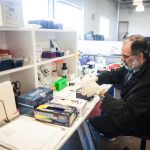Multidimensional Biomarker Discovery with Steve Daniel, PhD
In our last interview, we spoke with John Kuelper, Managing Director at Ascension Ventures. We’re continuing to speak to industry experts to get their perspective on what’s going on with immune-oncology, precision and personalized medicine and where we may be headed over the next few years. In the final episode of the series, David Shifrin is speaking with Steve Daniel, VP of Business Development at Cofactor. You can also listen to the entire recording on Soundcloud here.
David Shifrin: Let’s start off with a little bit more about your background. Please tell us who you are, where you came from, and some of your experiences.
Steve Daniel: I started out in the genomics space somewhat accidentally. I stayed at Stanford for a one year postdoc and became acquainted with microarray technology, which was very new at the time. That somewhat dates me here, but it was a very high throughput method for profiling gene expression. During my time as a graduate student, we would analyze one gene at a time and do northern blots to measure transcript levels, but not very accurately. All of a sudden, these fantastic tools it came to the forefront. I joined a company called Synteni as a research scientist at the bench and led a very small team to help develop methodologies for low input tissue samples.
At Synteni, I was exposed to the business development side of the genomics industry. I was asked to go out and every now and then, put a tie on, and give a talk about what we were doing. That spurred the evolution of my career away from the laboratory and into business development, which is what I’ve been up to for the past 25 years.
David Shifrin: It’s interesting to hear from someone who was there in the early days. You’ve got this unique perspective and have grown with the industry. I am curious to know what it was about Cofactor and their approach that attracted you to join?
Steve Daniel: The last six years or so of my career has been in the immune profiling space, specifically, profiling using next generation sequencing and uncovering the diversity and complexity of immune cells, T-cells, and B cells through immune repertoire sequencing. I had spent the last four years of my career prior to joining Cofactor with Adaptive Biotechnologies. They pioneered this method of sequencing a unique region of immune cells that undergoes massive rearrangement to generate the diversity of immune cell receptors. That’s what really got me focused in this space and immersed in oncology applications, biomarker discovery, and so forth.
Cofactor is bringing biomarker discovery in the IO space to the next level using machine learning techniques, which interested me. I understood that when using single biomarkers, there’s a lot of people that don’t benefit from therapies. This concept of using a Predictive Immune Modeling to build multidimensional biomarkers to provide to physicians, researchers, and clinicians that are taking drugs through a clinical development excites me, because I get it.
To me, it’s intuitive that these are the kinds of tools we are going to need moving forward. We’re now in the process of validating these approaches and working with clinical cohorts to demonstrate that these tools do provide greater predictive accuracy. As we continue to get this technology into the hands of additional clinicians and pharmaceutical researchers, we’re going to see more of this. It’s a powerful approach to understanding not just responses to immunotherapies, but any therapy that involves the immune system. The ImmunoPrism assay in particular and the machine learning approach that Cofactor is taking, is really going to revolutionize predictive biomarker application in this space.
David Shifrin: Steve, you talked a lot about the shift from a single biomarker to multidimensional approaches. What else would you include as some of the most important things that we’ve learned over the past 5-10 years in the immune-oncology and immune profiling space? I’m particularly interested to hear about what that means in the clinical setting for patients.
Steve Daniel: I think a multidimensional approach to understanding disease biology is intuitive. There are many factors that contribute to disease progression. I attended the IO Combinations 360 conference a month ago in Philadelphia and the focus was drug combinations in immune-oncology. Powerful combinations of checkpoint inhibitors and other types of therapeutics are showing great responses, which just validates the idea that there’s multiple pathways at work at the same time. If we can impinge upon these pathways simultaneously, we’re going to have longer, more durable responses and higher response rates.
David Shifrin: Are there any tools or approaches that don’t exist today that you think we need in order to do this at scale and in a clinically effective way?
Steve Daniel: One of the really exciting areas of immunotherapy is targeting the tumor with t-cells, and there’s a variety of ways to do that. There are bi-specific molecules where you make surface antigens and it’ll attract the T-cell to the specific tumor as well as other approaches where the T-cells themselves, like in the case of CAR-T, are engineered to recognize cell surface receptors on cells. The next generation of these technologies focus on solid tumor space. It’s going to require targeting the actual mutated proteins that the cancer cell itself is expressing and targeting those neoantigens, which the immune system does already. How we harness the immune system is really the forefront of effectively treating solid tumors using engineered T-cell therapies.
Methods for doing this need innovation. Refining how we pair these neoantigen specific receptors with mutated proteins will allow the engineered T-cell therapeutic developers to really target a patient’s specific tumor. A lot of innovation is going to be required in order to do it on a large scale and very quickly, so I’m excited about that. The next year or two will be exciting. There are a lot of smart people out there working on this and it’ll be fascinating to see what they come up with.
David Shifrin: So you really feel like the next year or two is going to be a turning point in that regard?
Steve Daniel: Oh, absolutely. I hate putting timelines on things, but the technology moves exponentially and there’s such a need on the solid tumor side. There’s excitement and success in the immunotherapy space and it’ll be fun to watch the field evolve but also contribute from a biomarker discovery standpoint. One of the things that we’re thinking about at Cofactor is not just the tumor specific approaches to cell-based solid tumor therapy, but the CAR-T space as well. The response rate is only 50-80%, which is great, but there’s still a subset of those populations that don’t respond to CAR-T and it’s not well understood why. We’re hoping with the ImmunoPrism Assay, and machine learning based methodologies for biomarker discovery, we’ll begin to uncover what characterizes responders from non-responders. We’re just now getting our technology into the hands of CAR-T developers to help answer these questions.
David Shifrin: You mentioned the solid tumor space and I know that’s an area Cofactor is focused on. There’s also this idea that we’ve been sort of dancing around – monitoring different tumor types, stages, and pre and post therapy in real time. There’s a lot of sampling that has to take place and that can be done either in the tumor itself or in the biofluids, which has implications for both the biology and the patient. Can you talk a little bit about how we can tie what’s going on at the site of the tumor with what’s going on in peripheral fluids?
Steve Daniel: That’s exactly the type of conversation that we are now having with the engineered t-cell developers. Before the patient even receives CAR-T, are there attributes of in the periphery that may predict who is going to benefit from this type of therapy? That’s where the ImmunoPrism assay comes in. We’ve been focusing in on the solid tumor environment and certainly we developed it to work with solid tumor tissues, whether it’s fresh, frozen, or fresh tissue or even paraffin embedded. Formalin-Fixed Paraffin-Embedded (FFPE) tissues are not the ideal way to store a sample for genetic analysis, but it’s how clinicians store tissues for histopathology. For immune cell profiling we give data on par with the gold standard techniques that don’t work with FFPE samples, like flow cytometry. Tying that back to monitoring and peripheral blood, the assay works. We’re not limited to the solid tumor environment. We can work with enriched immune cell populations, which is precisely the impetus for us to work with these types of companies to discover predictive markers.
The cost of the assay itself is relatively low and significantly scalable as sample numbers go up. It could be deployed out to clinical sites for use. Onsite samples don’t have to be shipped around the world to be tested. We certainly enable that, but our ImmunoPrism kit can be used externally by researchers in a clinical setting.
David Shifrin: Thanks again for taking the time. Anything else the audience needs to know?
Steve Daniel: I think that’s it for now. Stay tuned and watch us as we grow and get the ImmunoPrism assay into the hands of clinicians. It’s going to be an exciting deployment of the technology.
Cofactor’s ImmunoPrism™ Assay is offered both for Research Use Only (not to be used as a diagnostic assay) and as a CAP-validated assay. Please contact us to discuss which option is right for your application.





